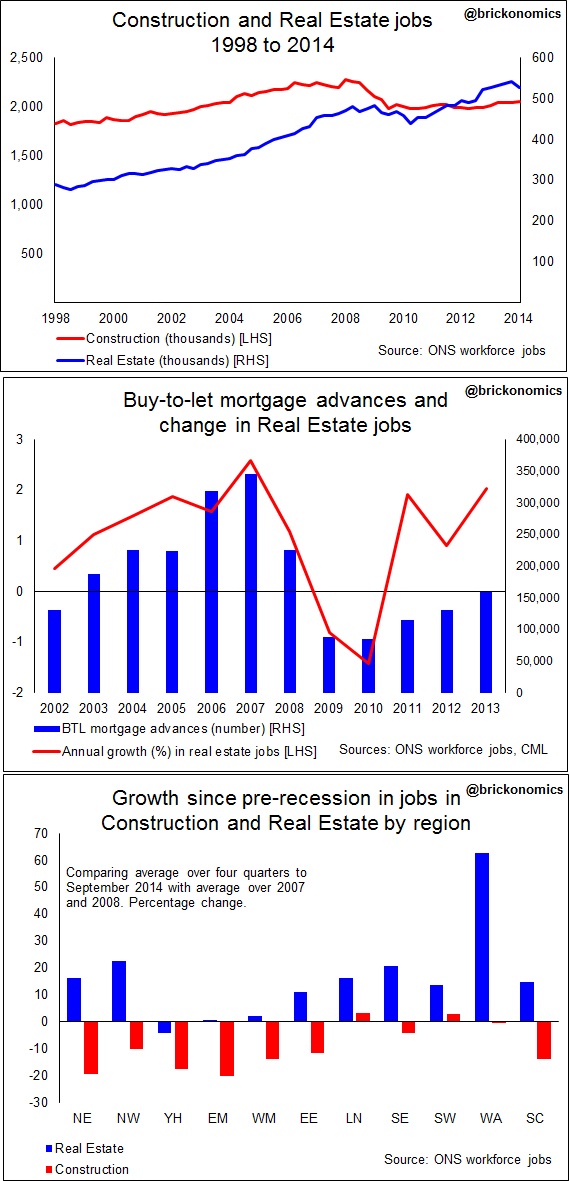What do we need more: people to build buildings or people to deal in them?
Here’s a question posed by the labour market figures: Why since the recession hit do we have more dealers in buildings and fewer people building them?
From the heady pre-recession days there seems to have been a 17% expansion in employment among dealers in buildings while employment among builders of buildings has shrunk 20%?
That seems to be what the employment data tables in the ONS labour market data release tell us.
Despite talk of a strong revival in construction, the 5% growth in real estate jobs over the year to last September overshadows the 2.5% growth in construction jobs.
To horny-handed sons of toil in construction all this will seem like a very strange way to rebalance the economy. It will seem a bizarre way to solve the housing crisis. It will seem fantastically inefficient. Indeed from all angles it will seem plain wrong and in need of some convincing explanation.
In fairness you can shrink the apparent problem by choosing different statistics. No this is not about lies damn lies and statistics. It’s just measuring a squidgy moving target is a lot more complicated than some people think.
The figures don’t look so bad if you examine the ONS preferred measure of short-term employment trends, the workforce jobs data. They show a drop of 11% for construction and a rise of 9% for real estate activities.
For my money the workforce jobs data may be better for most industries, but the fragmented itinerant nature of construction and its high level of self-employment present real problems in collecting and scaling the survey data. So the reality may be much worse than these data suggest and far closer to the bleaker picture painted by the employment data provided by the Labour Force Survey. But that’s a guess.
One advantage of the workforce jobs numbers is that they can also be broken regionally.
 Looking at the data that way does however torpedo any hope of finding an explanation in a quirk in regional distribution. It’s not just a London and South East thing. In all regions bar Yorkshire and Humberside real estate jobs are in greater numbers than at the pre-recession peak.
Looking at the data that way does however torpedo any hope of finding an explanation in a quirk in regional distribution. It’s not just a London and South East thing. In all regions bar Yorkshire and Humberside real estate jobs are in greater numbers than at the pre-recession peak.
(That said the data does reveal one very peculiar oddity. The biggest percentage growth in real estate jobs, by some margin, is in Wales. Don’t ask me to explain that one.)
As for construction jobs, there are far fewer in all regions bar London and the South West. Think wealth and the migration of wealth and you might find and explanation for that pattern.
There is of course another obvious suspect when we scour for an explanation for the phenomenal rise in estate agents – the rise of buy to let and private renting.
If you care to look at the numbers, cast them how you will, but the rise and fall in buy-to-let mortgages corresponds very neatly with the growth rate of real estate jobs.
That’s alright then, problem solved, we can explain why there are more estate agents jobs.
Well hang on. That’s not the real question.
The real question is whether it is more efficient to employ people in what is mainly transactional affairs rather than in productive affairs.
That I will leave to some clever politician or economist who can explain to me, and I suspect a rather perplexed construction industry, why in the face of a shortage it is imperative we increase the numbers of people allocating resources rather than the numbers creating them.